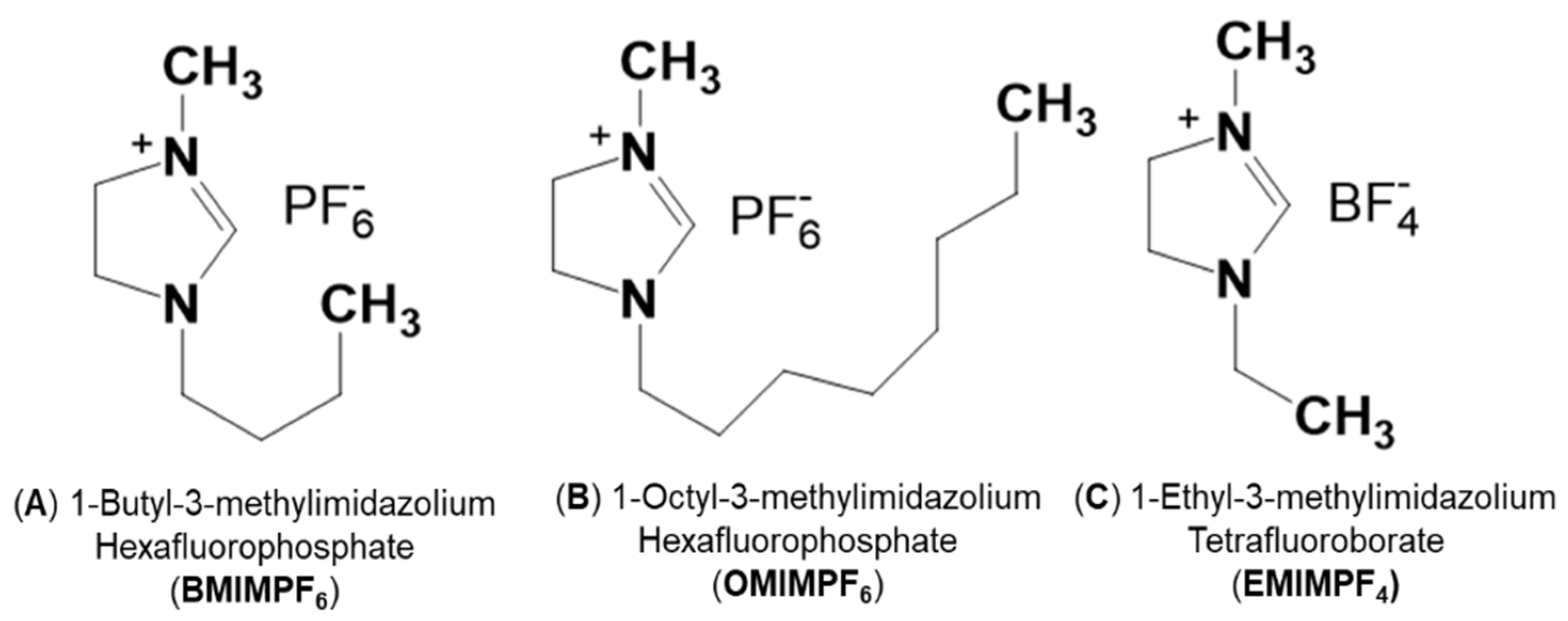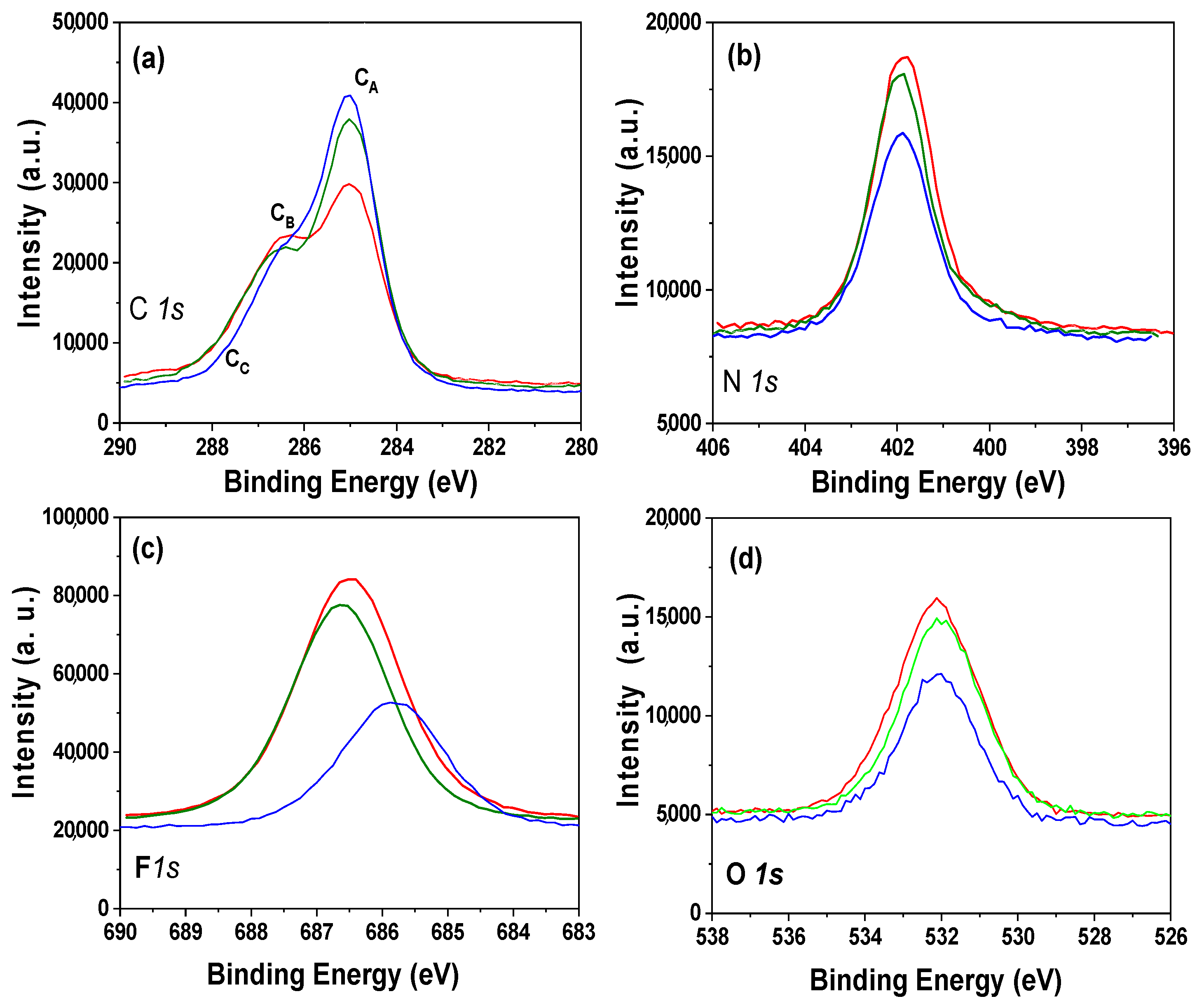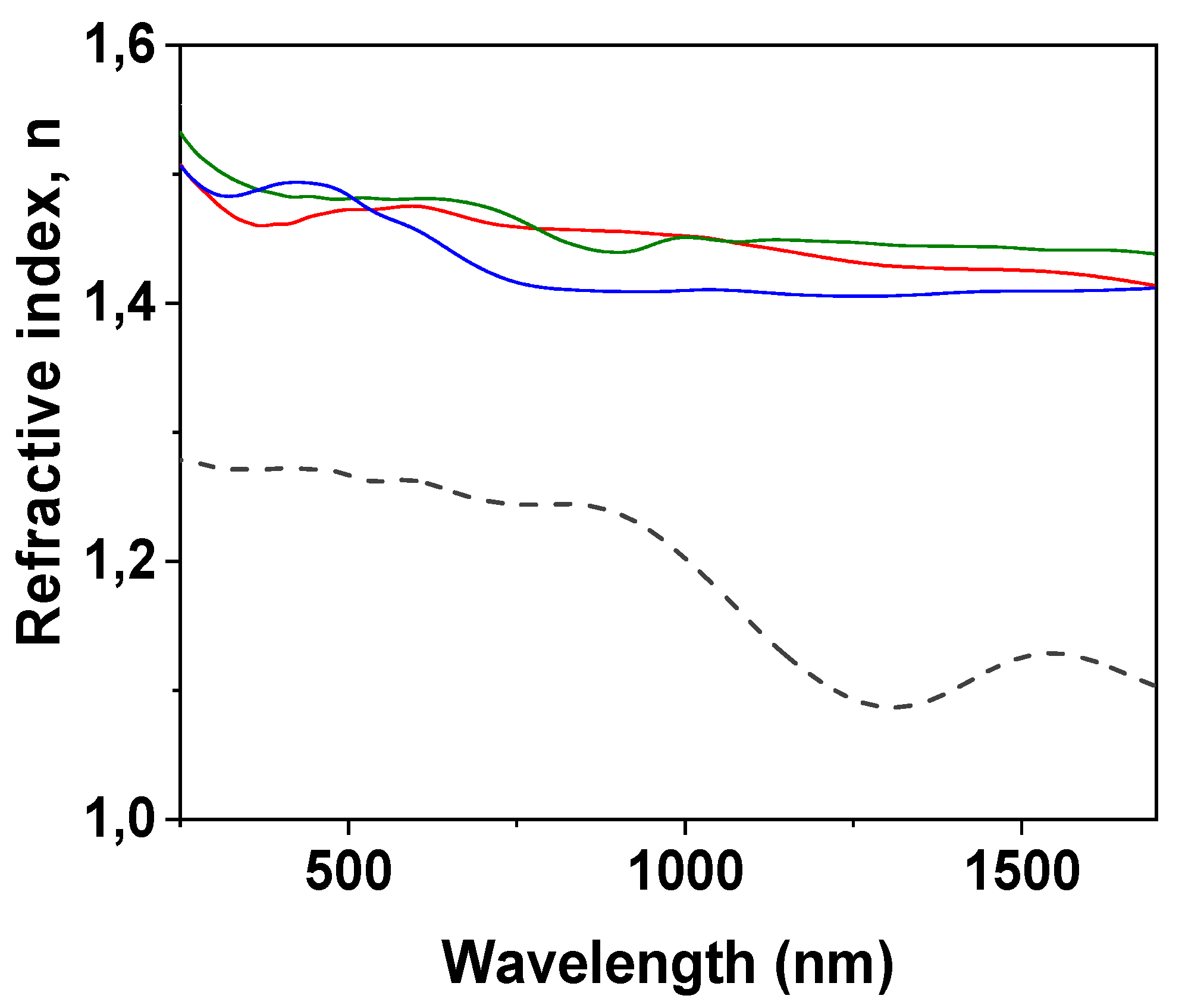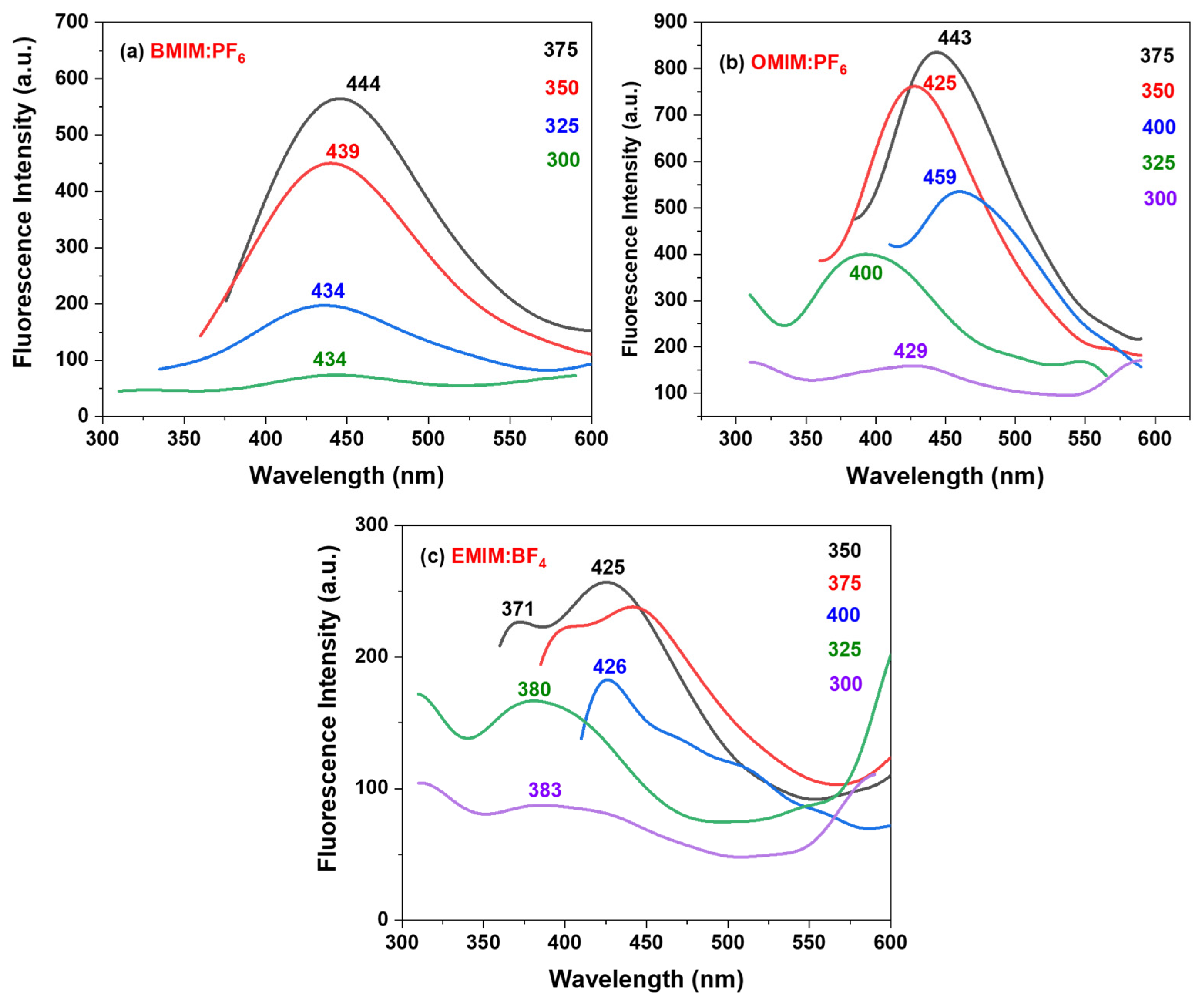Nanoporous Alumina Support Covered by Imidazole Moiety–Based Ionic Liquids: Optical Characterization and Application
Abstract
:1. Introduction
2. Materials and Methods
2.1. Materials
2.2. Preparation of the NPAS Modified by ILs Samples
2.3. Chemical Surface Analysis
2.4. Quantum Chemical Calculations
2.5. Optical Characterizations
2.6. I–V Curve Measurements
3. Results and Discussion
3.1. Chemical Surface Analysis
3.2. Interactions of Imidazole-Moieties with NAPS
3.3. Optical Characterization
3.4. Solar Cell Application
4. Conclusions
Supplementary Materials
Author Contributions
Funding
Data Availability Statement
Acknowledgments
Conflicts of Interest
References
- Kokorin, A. (Ed.) Ionic Liquids: Applications and Perspectives; IntechOpen: Rijeta, Croatia, 2011. [Google Scholar]
- Singh, S.K.; Savoy, A.W. Ionic liquids synthesis and applications: An overview. J. Mol. Liq. 2020, 297, 112038. [Google Scholar] [CrossRef]
- Welton, T. Room temperature ionic liquids. Solvent for synthesis and catalysis. Chem. Rev. 1999, 99, 2071–2084. [Google Scholar] [CrossRef] [PubMed]
- Thomas, P.A.; Bassy, B.; Marvey, B.B. Room Temperature Ionic Liquids as Green Solvent Alternatives in the Metathesis of Oleochemical Feedstocks. Molecules 2016, 21, 184. [Google Scholar] [CrossRef] [Green Version]
- Knipping, E.; Aucher, C.; Guirado, G.; Aubouy, L. Room temperature ionic liquids versus organic solvents as lithium–oxygen battery electrolytes. New J. Chem. 2018, 42, 4693–4699. [Google Scholar] [CrossRef]
- Abott, A.P.; McKenzie, K. Application of ionic liquids to the electrodeposition of metals. Phys. Chem. Chem. Phys. 2006, 8, 4265–4279. [Google Scholar] [CrossRef] [PubMed]
- Matsumoto, H.; Sakaebe, H.; Tatsumi, K. Preparation of room temperature ionic liquids based on aliphatic onium cations and asymmetrc amide anions as a lithium battery electrode. J. Power Sources 2006, 160, 1308–1313. [Google Scholar] [CrossRef]
- Yuyama, K.; Masuda, G.; Yoshida, H.; Sato, T. Ionic liquids containing the tetrafluoroborate anion have the best performance and stability for electric double layer capacitor applications. J. Power Sources 2006, 162, 1401–1408. [Google Scholar] [CrossRef]
- Armand, M.; Endres, F.; MacFarlane, D.R.; Ohno, H.; Scrosati, B. Ionic Liquids materials for the electrochemical changes of the future. Nat. Mater. 2009, 8, 621–629. [Google Scholar] [CrossRef]
- Neves, L.A.; Crespo, J.G.; Coelhoso, I.M. Gas Permeation Studies in Supported Ionic Liquid Membranes. J. Membr. Sci. 2010, 357, 160–170. [Google Scholar] [CrossRef]
- Zhao, Y.; Bostrom, T. Application of Ionic Liquids in solar cells and batteries: A review. Curr. Org. Chem. 2015, 19, 556–566. [Google Scholar] [CrossRef]
- Rojas, V.; Martínez, F.; Bernède, J.C.; Guenadez, L.C.; Efimov, A.; Lemmetyinen, H. Alkyl Thiophene Vinylene Electropolimerization in C8mimPF6, Potential Use in Solar Cells. Mater. Sci. Appl. 2017, 8, 405–417. [Google Scholar] [CrossRef] [Green Version]
- Piatti, E.; Guglielmero, L.; Tofani, G.; Mezzetta, A.; Guazzelli, L.; D’Andrea, F.; Roddaro, S.; Pomelli, C.S. Ionic liquids for electrochemical applications: Correlation between molecular structure and electrochemical stability window. J. Mol. Liq. 2022, 364, 120001. [Google Scholar] [CrossRef]
- Tang, X.; Lv, S.; Jiang, K.; Zhou, G.; Liu, X. Recent development of ionic liquid-based electrolytes in lithium-ion batteries. J. Power Sources 2022, 542, 231792. [Google Scholar] [CrossRef]
- Behera, K.; Pandey, S.; Kadyan, A.; Pandey, S. Ionic liquid-based optical and electrochemical carbon dioxide sensors. Sensors 2015, 15, 30487–30503. [Google Scholar] [CrossRef] [Green Version]
- Yuanchao, P.; Zhang, Y.; Ma, J.; Fan, M.; Zhang, S.; Wang, J. Ionic liquids for advanced materials. Mater. Today Nano 2022, 17, 100159. [Google Scholar] [CrossRef]
- Paul, A.; Mandal, P.K.; Samanta, A. On the optical properties of the imidazolium ionic liquids. J. Phys. Chem. B 2005, 109, 9148–9153. [Google Scholar] [CrossRef] [PubMed]
- Rizzo, A.; Canducci, C.; Telloli, C.; Ubaldini, A.; Bartolomei, P. Study of the optical properties of ionic liquids by Liquid Scintillation Counting. J. Mol. Liquids 2020, 302, 112359. [Google Scholar] [CrossRef]
- Correia, D.M.; Fernandes, L.C.; Fernandes, M.M.; Hermenegildo, M.; Meira, R.M.; Ribeiro, C.; Ribeiro, S.; Reguera, J.; Lanceros-Méndez, S. Ionic Liquid-Based Materials for Biomedical Applications. Nanomaterials 2021, 11, 2401. [Google Scholar] [CrossRef]
- Lee, J.; Panzer, M.J.; He, Y.; Lodge, T.P.; Frisbie, D.C. Ion gel gated polymer thin-film transistors. J. Am. Chem. Soc. 2007, 129, 4532–4533. [Google Scholar] [CrossRef]
- JingBai, J.; Zhang, B.; Yang, B.; Shang, J.; Wu, Z. Preparation of three-dimensional interconnected graphene/ionic liquid composites to enhanced thermal conductivities for battery thermal management. J. Cleaner Product. 2022, 370, 133572. [Google Scholar] [CrossRef]
- Feng, P.; Wang, X.; Lu, B.; Pan, G.; Leng, X.; Ma, X.; Zhang, J.; Zhao, W. Ionic liquids-filled patterned cavities improve transmittance of transparent and stretchable electronic polydimethylsiloxane films. J. Mater. Sci. 2019, 54, 11134–11144. [Google Scholar] [CrossRef]
- Kanj, A.B.; Verma, R.; Liu, M.; Helfferich, J.; Wenzel, W.; Heinke, L. Bunching and Immobilization of Ionic Liquids in Nanoporous Metal−Organic Framework. Nano Lett. 2019, 19, 2114–2120. [Google Scholar] [CrossRef] [PubMed]
- Muginova, S.; Myasnikova, D.A.; Kazarian, S.-G.; Shekhovtsova, T.N. Applications of ionic liquids for the development of optical chemical sensors and biosensors. Anal. Sci. 2017, 33, 261–274. [Google Scholar] [CrossRef] [PubMed] [Green Version]
- Kowal, D.; Rola, K.; Cybinska, J.; Skorenski, M.; Zajac, A.; Szpecht, A.; Smiglak, M.; Drobczynsi, S.; Ciesiolkiewicz, K.; Komorowska, K. Fluorescent ionic liquid micro reservoirs fabricated by dual-step E-beam patterning. Mater. Res. Bull. 2021, 142, 111434. [Google Scholar] [CrossRef]
- Xin, B.; Hao, J. Imidazolium-based ionic liquids grafted on solid surfaces. Chem. Soc. Rev. 2014, 43, 7171–7187. [Google Scholar] [CrossRef]
- Perkin, S. Ionic liquids in confined geometries. Phys. Chem. Chem. Phys. 2012, 14, 5052–5062. [Google Scholar] [CrossRef]
- Masuda, H.; Fukuda, K. Ordered metal nanohole arrays by a two-step replication of honeycomb structures of anodic alumina. Science 1995, 268, 1466–1468. [Google Scholar] [CrossRef]
- Lee, W.; Park, S.J. Porous anodic aluminum oxide: Anodization and template synthesis of functional nanostructures. Chem. Rev. 2014, 114, 7487–7556. [Google Scholar] [CrossRef]
- Ruíz-Clavijo, A.; Caballero-Calero, O.; Martín-González, M. Revisiting anodic alumina templates: From fabrication to applications. Nanoscale 2021, 13, 2227–2265. [Google Scholar] [CrossRef]
- Vega, V.; Gelde, L.; González, A.S.; Prida, V.M.; Hernando, B.; Benavente, J. Diffusive transport through surface functionalized nanoporous alumina membranes by atomic layer deposition of metal oxides. Ind. Chem. Eng. J. 2017, 52, 66–72. [Google Scholar] [CrossRef]
- Martín, R.; Manzano, C.V.; Martín-González, M. In-depth study of self-ordered porous alumina in the 140–400 nm pore diameter range. Micropor. Mesopor. Mat. 2012, 151, 311–316. [Google Scholar] [CrossRef]
- Nielsch, K.; Choi, J.; Schwirn, K.; Wehrspohn, R.B.; Gösele, U. Self-ordering regimes of porous alumina: The 10% porosity rule. Nano Lett. 2002, 2, 677–680. [Google Scholar] [CrossRef]
- Santos, A.; Fomentin, P.; Pallarès, J.; Ferré-Borrull, J.; Marsal, L.F. Structural engineering of nanoporous anodic alumina funnels with high aspect ratio. J. Electroanal. Chem. 2011, 655, 73–78. [Google Scholar] [CrossRef]
- George, S.M. Atomic layer deposition: An overview. Chem. Rev. 2010, 110, 111–131. [Google Scholar] [CrossRef] [PubMed]
- Gelde, L.; Cuevas, A.; Martínez de Yuso, M.V.; Benavente, J.; Vega, V.; González, A.S.; Prida, V.M.; Hernando, B. Influence of TiO2-coating layer on nanoporous alumina membranes by ALD technique. Coatings 2018, 8, 60. [Google Scholar] [CrossRef] [Green Version]
- González, A.S.; Vega, V.; Cuevas, A.L.; Martínez de Yuso, M.V.; Prida, V.M.; Benavente, J. Surface Modification of Nanoporous Anodic Alumina during Self-Catalytic Atomic Layer Deposition of Silicon Dioxide from (3-Aminopropyl)Triethoxysilane. Materials 2021, 17, 5052. [Google Scholar] [CrossRef]
- Wang, X.; Zhou, Q. Refractive Index of Ionic Liquids. In Encyclopedia of Ionic Liquids; Zhang, S., Ed.; Springer: Singapore, 2020. [Google Scholar] [CrossRef]
- Cuevas, A.L.; Gonzalez, A.S.; Vega, V.; Prida, V.M.; Benavente, J. Optical and Electrochemical Characterization of Nanoporous Alumina Structures: Pore Size, Porosity, and Structure Effect. Appl. Sci. 2020, 10, 4864. [Google Scholar] [CrossRef]
- Matthew, J. Surface Analysis by Auger and X-ray Photoelectron Spectroscopy; Briggs, D., Grant, J.T., Eds.; IMPublications: Chichester, UK; SurfaceSpectra: Manchester, UK, 2004. [Google Scholar]
- Fortunato, R.; Afonso, C.A.M.; Benavente, J.; Rodríguez-Castellón, E.; Crespo, J.G. Stability of supported ionic liquid membranes as studied by X-ray photoelectron spectroscopy. J. Membr. Sci. 2005, 256, 216. [Google Scholar] [CrossRef]
- Lockett, V.; Sedev, R.; Bassell, C.; Ralston, J. Angle-resolved X-ray photoelectron spectroscopy of the surfaces of imididazolium ionic liquids. Phys. Chem. Chem. Phys. 2008, 10, 1330–1335. [Google Scholar] [CrossRef]
- Yanai, T.; Tew, D.; Handy, N. A new hybrid exchange-correlation functional using the Coulomb-attenuating method (CAM-B3LYP). Chem. Phys. Lett. 2004, 393, 51–57. [Google Scholar] [CrossRef] [Green Version]
- Weigend, F.; Ahlrichs, R. Balanced basis sets of split valence, triple zeta valence and quadruple zeta valence quality for H to Rn: Design and assessment of accuracy. Phys. Chem. Chem. Phys. 2005, 7, 3297–3305. [Google Scholar] [CrossRef] [PubMed]
- Weigend, F. Accurate Coulomb-fitting basis sets for H to Rn. Phys. Chem. Chem. Phys. 2006, 8, 1057–1065. [Google Scholar] [CrossRef] [PubMed]
- Frisch, M.J.; Trucks, G.W.; Schlegel, H.B.; Scuseria, G.E.; Robb, M.A.; Cheeseman, J.R.; Scalmani, G.; Barone, V.; Petersson, G.A.; Nakatsuji, H.; et al. Gaussian 16, Revision A.03; Gaussian, Inc.: Wallingford, CT, USA, 2016. [Google Scholar]
- Algarra, M.; Soto, J. Insights into the Thermal and Photochemical Reaction Mechanisms of Azidoacetonitrile. Spectroscopic and MS-CASPT2 Calculations. ChemPhysChem 2020, 21, 1126–1133. [Google Scholar] [CrossRef]
- Soto, J.; Algarra, M. Electronic Structure of Nitrobenzene: A Benchmark Example of the Accuracy of the Multi-State CASPT2 Theory. J. Phys. Chem. A 2021, 125, 9431–9437. [Google Scholar] [CrossRef] [PubMed]
- Soto, J.; Pelaez, J.D.; Otero, J.C. A SA-CASSCF and MS-CASPT2 study on the electronic structure of nitrosobenzene and its relation to its dissociation dynamics. J. Chem. Phys. 2021, 154, 044307. [Google Scholar] [CrossRef]
- Bode, B.M.; Gordon, M.S. MacMolPlt: A graphical user interface for GAMESS. J. Mol. Graphics Modell. 1998, 16, 133–138. [Google Scholar] [CrossRef]
- Schaftenaar, G.; Noordik, J.H. Molden: A pre- and post-processing program for molecular and electronic structures. J. Comput.-Aided Mol. Des. 2000, 14, 123–134. [Google Scholar] [CrossRef]
- Tompkins, H.G.; Hilfiker, J.N. Spectroscopic Ellipsometry: Practical Application to Thin Film Characterization in Materials Characterization and Analysis Collection; Brundle, C.R., Ed.; Momentum Press: New York, NY, USA, 2016; ISBN 978-1-60650-727-8. [Google Scholar]
- UNE-EN IEC 60904-9:2021; Photovoltaic Devices–Part 9: Classification of Solar Simulator Characteristics. International Standard: Geneve, Swizerland, 2021.
- Moulder, J.F.; Stickle, W.F.; Sobol, P.E.; Bomben, K.D. Handbook of X-ray Photoelectron Spectroscopy; Chastain, J., Ed.; Perkin-Elmer Corporation: Minneapolis, MN, USA, 1992. [Google Scholar]
- Martínez de Yuso, M.V.; Neves, L.A.; Coelhoso, I.M.; Crespo, J.G.; Benavente, J.; Rodríguez-Castellón, E. A study of chemical modifications of a Nafion membrane by incorporation of different room temperature ionic liquids. Fuel Cells 2012, 12, 606–613. [Google Scholar] [CrossRef]
- Foelske-Schmitz, A.; Weingarth, D.; Kaiser, H.; Kötz, R. Quasi in situ XPS study of anion intercalation into HOPG from the ionic liquid [EMIM][BF4] A. Electrochem. Communications 2010, 12, 1453–1456. [Google Scholar]
- Vázquez, M.I.; Romero, V.; Vega, V.; García, J.; Prida, V.M.; Hernado, B.; Benavente, J. Morphological, Chemical Surface, and Diffusive Transport Characterizations of a Nanoporous Alumina Membrane. Nanomaterials 2015, 5, 2192–2202. [Google Scholar] [CrossRef]
- Zamani, M. Density functional study of the structure and water adsorption activity of an Al30O30 star-shaped alumina nanocage. Turk. J. Chem. 2016, 40, 54–64. [Google Scholar] [CrossRef]
- Clark, T.; Murray, J.S.; Politzer, P. A perspective on quantum mechanics and chemical concepts in describing noncovalent interactions. Phys. Chem. Chem. Phys. 2018, 20, 30076–30082. [Google Scholar] [CrossRef] [PubMed]
- Algarra, M.; Moreno, V.; Lazaro-Martinez, J.M.; Rodriguez-Castellon, E.; Soto, J.; Morales, J.; Benitez, A. Insights into the formation of N doped 3D-graphene quantum dots. Spectroscopic and computational approach. J. Colloid Interface Sci. 2020, 561, 678–686. [Google Scholar] [CrossRef]
- Tran, C.D.; De Paoli LaCerda, S.H.; Oliveira, D. Absorption of Water by Room-Temperature Ionic Liquids: Effect of Anions on Concentration and State of Water. Appl. Spectrosc. 2003, 57, 152–157. [Google Scholar] [CrossRef] [PubMed]
- Yang, J.; Zhang, D.; Li, Y. How to remove the influence of trace water from the absorption spectra of SWNTs dispersed in ionic liquids. Beilstein J. Nanotechnol. 2011, 2, 653–658. [Google Scholar] [CrossRef] [Green Version]
- Houdova, D.; Soto, J.; Castro, R.; Rodrigues, J.; Pino-Gonzalez, M.S.; Petkovic, M.; Bandosz, T.J.; Algarra, M. Chemically heterogeneous carbon dots enhanced cholesterol detection by MALDI TOF mass spectrometry. J. Colloid Interface Sci. 2021, 591, 373–383. [Google Scholar] [CrossRef]
- Ducic, T.; Alves, C.S.; Vucinic, Z.; Lazaro-Martinez, J.M.; Petkovic, M.; Soto, J.; Mutavdzic, D.; de Yuso, M.V.M.; Radotic, K. N-doped carbon dots-based cisplatin delivery system in adenocarcinoma cells: Spectroscopical and computational approach. J. Colloid Interface Sci. 2022, 623, 226–237. [Google Scholar] [CrossRef]
- Cuevas, A.L.; Martínez de Yuso, M.V.; Gelde, L.; González, A.S.; Vega, V.; Cuevas, A.L.; Prida, V.M.; Benavente, J. Chemical, optical and transport characterization of ALD modified nanoporous alumina based structures. J. Ind. Eng. Chem. 2020, 91, 139–148. [Google Scholar] [CrossRef]
- Algarra, M.; Cuevas, A.L.; de Yuso, M.V.M.; Romero, R.; Alonso, B.; Casado, C.M.; Benavente, J. Optical and Physicochemical Characterizations of a Cellulosic/CdSe-QDs@S-DAB5 Film. Nanomaterials 2022, 12, 484. [Google Scholar] [CrossRef]
- Law, C.S.; Lim, S.Y.; Abell, A.D.; Voelcker, N.H.; Santos, A. Nanoporous Anodic Alumina Photonic Crystals for Optical Chemo- and Biosensing: Fundamentals, Advances, and Perspectives. Nanomaterials 2018, 8, 788. [Google Scholar] [CrossRef]
- Yamamoto, Y.; Baba, N.; Tajima, S. Coloured materials and photoluminescence centres in anodic film on aluminium. Nature 1981, 289, 572–574. [Google Scholar] [CrossRef]
- Rauf, A.; Mehmood, M.; Ahmed, M.; Hasan, M.; Aslan, M. Effect of ordering quality of the pores on the photoluminescence of porous alumina prepared in aoxalix acid. J. Lumin. 2010, 130, 792–800. [Google Scholar] [CrossRef]
- Santos, A.; Alba, M.; Rahman, M.M.; Formentín, P.; Ferré-Borrull, J.; Pallarés, J. Structural tuning of photoluminescence in nanoporous anodic alumina by hard anodization in oxalic and malonic acids. Nanoscale Res. Let. 2012, 7, 22. [Google Scholar] [CrossRef] [Green Version]
- Aniruddha, P.; Prasun, K.M.; Anunay, S. How transparent are the imidazolium ionic liquids? A case study with 1-methyl-3-butylimidazolium hexafluorophosphate, [bmim][PF6]. Chem. Phys. Let. 2005, 402, 375–379. [Google Scholar]
- López-Escalante, M.C.; Fernández-Rodríguez, M.; Caballero, L.J.; Martín, F.; Gabás, M.; Ramos-Barrado, J.R. Novel encapsulant architecture on the road to photovoltaic module power output increase. Appl. Energy 2018, 228, 1901–1910. [Google Scholar] [CrossRef]








| ILs | Molecular Weight (g/mol) | Molar Volume (cm3/mol) | Density (kg/m3) | Viscosity (mPa·s) | Refractive Index * |
|---|---|---|---|---|---|
| BMIMPF6 | 284.2 | 182 | 1.38 × 103 | 229 | 1.409 |
| OMIMPF6 | 340.3 | 266 | 1.23 × 103 | 522/1000 | 1.417 |
| EMIMBF4 | 197.9 | 159 | 1.29 × 103 | 76/108 | 1.405 |
| Sample | C (%) | N (%) | F (%) | P (%) | B (%) | Al (%) | O (%) |
| BMIMPF6/NPAS | 4 48.8 | 7.4 | 24.8 | 5.5 | ---- | 5.1 | 8.3 |
| OMIMPF6/NPAS | 5 55.4 | 7.2 | 21.4 | 5.0 | ---- | 3.9 | 7.0 |
| EMIMBF4NPAS * | 6 63.5 | 6.6 | 14.3 | ---- | 5.6 | 3.1 | 6.1 |
| Sample | (C/N) E (C/N) T | (F/N) E (F/N) T | (C/F) E (C/F) T | (F/P) E (F/P) T | (F/B) E (F/B) T | (O/Al) E(O/Al) T | |
| NPAS/BMIMPF6 | 4 6.6 4.0 | 3.4 3.0 | 2.0 1.3 | 4.5 6.0 | - - | 1.6 1.5 | |
| NPAS/OMIMPF6 | 5 7.7 6.0 | 3.0 3.0 | 2.6 2.0 | 4.3 6.0 | - - | 1.8 1.5 | |
| NPAS/EMIMBF4 | 6 9.6 3.0 | 2.2 2.0 | 4.4 1.5 | - - | 2.6 4.0 | 2.0 1.5 | |
| System | ΔaE (Kcal/mol) |
|---|---|
| BMIMPF6/NPAS | −59.5 |
| OMIMPF6/NPAS | −89.8 |
| EMIMBF4/NPAS | −97.0 |
| Sample | <nv> | <nnir> |
|---|---|---|
| BMIMPF6/NPAS | 1.467 ± 0.006 | 1.437 ± 0.013 |
| OMIMPF6/NPAS | 1.480 ± 0.010 | 1.445 ± 0.003 |
| EMIMBF4/NPAS | 1.461 ± 0.029 | 1.408 ± 0.002 |
| Sample | T % (600 nm) | T % (1000 nm) | T % (1500 nm) | T % (2000 nm) |
|---|---|---|---|---|
| BMIMPF6/NPAS | 82.3 | 91.0 | 92.1 | 92.3 |
| OMIMPF6/NPAS | 86.2 | 91.6 | 91.5 | 92.4 |
| EMIMBF4/NPAS | 80.5 | 89.5 | 91.5 | 92.0 |
| Sample | Isc (mA) | Pmp (mW) |
|---|---|---|
| NPAS | 46.44 | 11.38 |
| BMIMPF6/NPAS | 55.15 | 14.08 |
| OMIMPF6/NPAS | 57.27 | 14.74 |
| EMIMBF4/NPAS | 50.53 | 12.67 |
Publisher’s Note: MDPI stays neutral with regard to jurisdictional claims in published maps and institutional affiliations. |
© 2022 by the authors. Licensee MDPI, Basel, Switzerland. This article is an open access article distributed under the terms and conditions of the Creative Commons Attribution (CC BY) license (https://creativecommons.org/licenses/by/4.0/).
Share and Cite
Algarra, M.; López Escalante, M.C.; Martínez de Yuso, M.V.; Soto, J.; Cuevas, A.L.; Benavente, J. Nanoporous Alumina Support Covered by Imidazole Moiety–Based Ionic Liquids: Optical Characterization and Application. Nanomaterials 2022, 12, 4131. https://doi.org/10.3390/nano12234131
Algarra M, López Escalante MC, Martínez de Yuso MV, Soto J, Cuevas AL, Benavente J. Nanoporous Alumina Support Covered by Imidazole Moiety–Based Ionic Liquids: Optical Characterization and Application. Nanomaterials. 2022; 12(23):4131. https://doi.org/10.3390/nano12234131
Chicago/Turabian StyleAlgarra, Manuel, Mª Cruz López Escalante, Mª Valle Martínez de Yuso, Juan Soto, Ana L. Cuevas, and Juana Benavente. 2022. "Nanoporous Alumina Support Covered by Imidazole Moiety–Based Ionic Liquids: Optical Characterization and Application" Nanomaterials 12, no. 23: 4131. https://doi.org/10.3390/nano12234131





